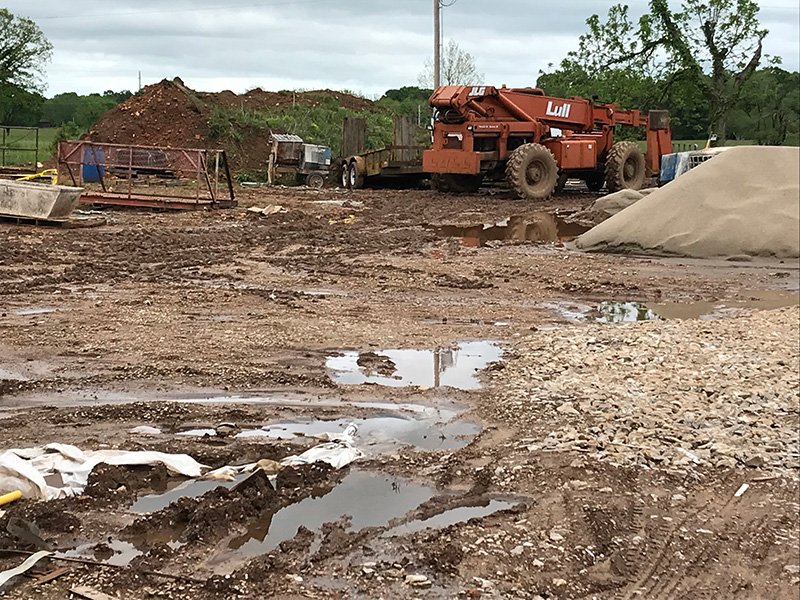From Concrete to Conservation: Difficulties in Landscape (Soils) Restoration
Landscape restoration is a situation us Groundskeepers regularly find ourselves in. While some may hear this term and think native prairie or landfill recovery, it also applies to much of our everyday work too. Landscape restoration is about big ticket projects, but it is also about fostering the multitude of natural processes that take place in the living environments we manage every day. For the last 18 months I have been participating in two restoration projects. One is seeking to transform a vacant lot (former downtown warehouse space) into a semblance of a native Missouri savannah/prairie edge. The other is attempting to cultivate a stand of turf on a very recently demolished building lot (100% concrete cover) after years under pavement. Trying to return these sites to a modicum of health whereby they can support a landscape has exposed several issues that can make restoration effective.
It is easier to protect it than correct it.
Site degradation during construction or renovation is largely unavoidable. If there is a building, parking lot, or similar on your site, heavy machinery will be required to perform the first phases of renovation in order to demolish and remove these structures/materials. If you happen to be building on a new site, or components of the site are to remain as is, this heavy disruption may not be as widespread. Regardless, heavy machinery frequently damages components of the site (especially soil) that are to remain and will form the foundation of what is to be rebuilt. Creating no drive zones, covering site with a heavy coating of mulch, or limiting what equipment can be employed on site can all prevent site damage. In addition, I suggest getting all members (grounds professionals or not) to consider site degradation is the approach with the greatest impact. In most cases the old adage “an ounce of prevention is worth a pound of cure” applies.

Grounds Professionals Must Drive the Recovery Protocol
Restoration at a degraded site must follow a reasonable protocol based in good science and grounds management cultural practices. Too frequently the recovery process is dictated by members of the construction team with expertise outside the necessary cultural sphere. “Good black dirt” likely means one thing to excavators and something completely different to Groundskeepers. Soil should be tested before it is approved for use to restore the site. Soil should have the attributes necessary to promote turf and plant growth. Just because a soil is workable doesn’t mean it is suitable for growing crops. Excavator seem to be primarily interested in the way a soil can be spread and levelled. Pulverized soil might work easily but it has no structure or organisms, both of which are essential to good landscape uses. I also believe that the excavator is too focused on the visible top layer of soil. Camouflaged stratification, buried trash and debris, massive compaction and soil inconsistencies all will retard positive results. By unifying the goals/methods of both contractor and Groundskeeper, better results are likely.

Each Site is Unique
For our native restoration, we performed a site analysis and made our initial decisions based on this assessment and our project objectives. Much of this site was formerly a gravel parking lot. It had a crop of weeds (black medic, clover, yellow sweet clover) but no plants from our target list. Our goal was to overseed with soybeans to provide a cover crop, but our seed germinated then perished due to drought. I thought this was a setback until I read up on Sweet Clover (Melilotus officinalis) and found it was very desirable cover crop with a host of restoration benefits. I let this crop grow last year but kept it mowed down regularly. Taking advantage of what the site is telling you has benefits.
In our turf establishment project, our biggest obstacle is the soil structure and compaction. The soil that was brought in contained significant clay and silt. It had also been shredded to the consistency of talc. These 2 factors led to compaction over a 6-12” depth (depending on rough grading of site). Our turfgrass grew but stopped growing readily at about 3” top growth. I suggest that the compaction, and water holding capacity of clay, combine to create an anaerobic situation that prevents roots form penetrating deeper into soil. Unfortunately, until the soil forms some aggregate, core aeration won’t provide much relief (think core aerating sand). The lack of organisms that can break down organic matter also has a negative impact on soil structure and fertility.

Healthy Landscapes will not appear overnight
Healthy landscapes are highly complex systems. This complexity is disguised and sometimes overlooked because of the straight forwardness associated with their success as systems. Plants grow, landscapes survive, grass persists, so how difficult can it be to maintain a healthy landscape. Their success obscures the amazing chemical, biological, and physical interactions and inter-relationships that must occur constantly. Both of these landscapes were massively disrupted and degraded. The damage wrought on soil by development is catastrophic and long lasting. The turf project soil has no worms or ants, and therefore I expect very few soil organisms. The gravel lot in the prairie project is essentially concrete (it doesn’t percolate water despite being aggregate). You cannot quickly overcome sterility with cultural approaches. You can help to create the conditions that will promote recovery (top dressing with organic matter, mowing higher, limit harsh chemicals, etc.) but recovery and ecosystem restoration takes time.



0 Comments
Recommended Comments
There are no comments to display.